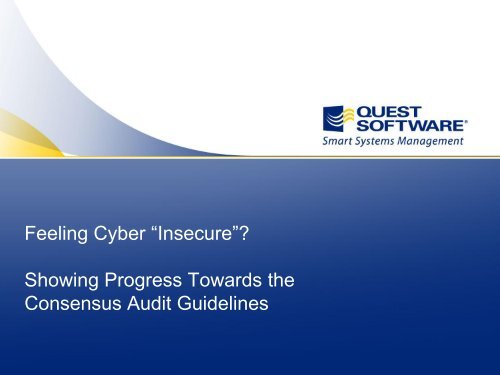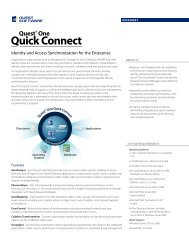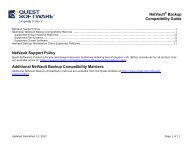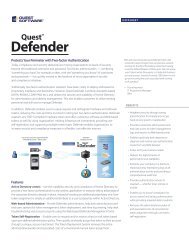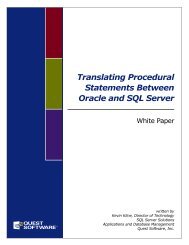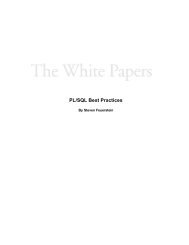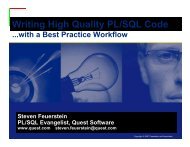Feeling Cyber “Insecure”? Showing Progress ... - Quest Software
Feeling Cyber “Insecure”? Showing Progress ... - Quest Software
Feeling Cyber “Insecure”? Showing Progress ... - Quest Software
Create successful ePaper yourself
Turn your PDF publications into a flip-book with our unique Google optimized e-Paper software.
<strong>Feeling</strong> <strong>Cyber</strong> <strong>“Insecure”</strong>?<br />
<strong>Showing</strong> <strong>Progress</strong> Towards the<br />
Consensus Audit Guidelines<br />
© 2008 <strong>Quest</strong> <strong>Software</strong>, Inc. ALL RIGHTS RESERVED.
Overview<br />
• Paul Garver, Vice President, <strong>Quest</strong> Public Sector<br />
2
<strong>Cyber</strong>attacks Are Real<br />
“In April 2009, government officials confirmed that since<br />
2007, hackers have been slipping into computer systems<br />
behind the Joint Strike Fighter weapons project. They gained<br />
access through defense contractors on the project.”<br />
“In 2008, the Office of the Inspector General (OIG) says,<br />
hackers took over FAA Servers in Alaska, discovered<br />
the password of an administrator in Oklahoma and got<br />
access to 40,000 FAA user names and passwords.”<br />
CIO Magazine<br />
July 1, 2009<br />
CIO Magazine<br />
July 1, 2009<br />
“In February 2009, an FAA web site was hacked,<br />
exposing data on 48,000 current and former<br />
employees, according to a recent study by the OIG.”<br />
CIO Magazine<br />
July 1, 2009
The Reality<br />
"You can be FISMA compliant and still not be secure."<br />
“Next month the Office of Management and Budget will<br />
announce new performance metrics for FISMA, so that<br />
agencies can move from static, compliance-based security<br />
to risk management based on real-time monitoring and<br />
analysis.”<br />
- FCW March 2, 2010<br />
Interview with Howard Schmidt, White House <strong>Cyber</strong>security Coordinator
It’s Our Job to Act<br />
• At least 34 federal regulations apply to organizations that<br />
touch critical IT infrastructure in the U.S.<br />
• This is a collection of rules that no one person, agency or<br />
department oversees and includes mandates from:<br />
• Fragmentation like this means uniformly measured and<br />
monitored security standards across industries don’t exist.<br />
“The current approach of trying to do everything,<br />
everywhere, results in accomplishing little, anywhere.”<br />
- Daniel Mintz, CTO, Consulting Firm CSC,<br />
former CIO, US Dept. of Transportation<br />
Source: Government Accountability Office
<strong>Quest</strong> Value: Four Pillars of Transformation<br />
• Active Directory and Identity Management<br />
– State Department AD provisioning<br />
– IDM at NASA, IRS, DHS/ICE<br />
• Unified Communications<br />
– Exchange management at ICE, USSS, CBP<br />
– ADEX modernization US Army, USAF worldwide<br />
– IM audit and security across the intel community<br />
• Application & Database Performance Management<br />
– End user performance at TSA, US VISIT, BPD<br />
– Oracle and Java diagnostics at FBI, TSA, US VISIT<br />
• Virtualization Management<br />
– DHS CBP iLab, FLETC, USCG<br />
– Desktop virtualization at Centcom
The State of Security<br />
• Dennis Heretick, Independent Contractor<br />
– Former Chief Information Security Officer, Department of Justice<br />
8
Risk Assessment Factors<br />
• Vulnerability or Threats Minus Countermeasures<br />
– Threat Exploitability (EX) minus countermeasures (CT)<br />
• Likelihood<br />
– Threat source capability, motivation, gain<br />
– History and/or predicted success<br />
– Capability to detect or attribute to source<br />
• Mission Impact Level<br />
– Mission operations, assets, people, other organizations, national<br />
interests<br />
9
Threat Categories and Sources<br />
• Threat Categories<br />
– Hacking and intrusion<br />
– Malware<br />
– Insider misuse and abuse<br />
– Social attacks and deceit<br />
– Errors and omissions<br />
– Physical attacks<br />
– Natural disasters, accidents<br />
• Threat Sources<br />
– Internal<br />
– External<br />
– Partner<br />
10
Risk Control<br />
• Analyze Mission Risk Control Requirements<br />
– Review implemented and planned controls<br />
– Use policy based requirements checklist for security testing<br />
• Prioritize, Plan and Implement Risk Controls<br />
– Effectiveness of recommend options<br />
– Legislation and regulation<br />
– Operational impact<br />
– Safety and reliability<br />
11
Secure Federal File Sharing Act – HR 4098<br />
• Within 90 days of enactment, OMB, in consultation with Federal<br />
CIO Council will issue guidance to:<br />
– Prohibit open network peer-to-peer file sharing unless they are:<br />
• Necessary for business operations<br />
• Instrumental to directly support agency’s mission<br />
• Necessary for use between, among or within Federal, State or<br />
Local government<br />
• Within 180 days of enactment, agencies will:<br />
– Establish personal use policies<br />
– Require agency contractors to comply<br />
– Update security and ethics policies<br />
– Ensure proper security controls are in place<br />
• One year after enactment OMB will report on agency<br />
justification and provide an inventory of peer-to-peer use<br />
12
The State of Security<br />
• John Milburn, Vice President, Windows Business Unit<br />
13
Survey Says:<br />
Online survey of government IT executives highlights top five security priorities:<br />
Mobile devices (encryption,<br />
physical security)<br />
(59%)<br />
Physical plant intrusion<br />
detection, access control<br />
via identity management<br />
(53%)<br />
Virtualized environments<br />
and cloud computing<br />
(31%)<br />
“Identity management tools were ranked in the<br />
top 5 among security investments to be made<br />
this year by 37% of survey respondents.”<br />
- Online Survey of Government IT Executives,<br />
1105 Government Information Group, June 2009<br />
Source: 1105 Government Information Group, June 2009<br />
Protection from<br />
cyberattacks on critical<br />
infrastructure<br />
(42%)<br />
Network<br />
architecture<br />
(35%)
<strong>Quest</strong> Can Help You:<br />
✔<br />
✔<br />
✔<br />
✔<br />
✔<br />
✔<br />
1. Lock down the infrastructure<br />
Safeguard user identities, protect important information and preserve other<br />
mission-critical applications<br />
2. Ensure resiliency<br />
Achieve swift and comprehensive recovery in the event there is a security<br />
breach – minor or catastrophic<br />
3. Be 100% reliable<br />
Rely on our proven track record of ensuring security and protection, both inside and<br />
outside of your organization<br />
4. Deliver comprehensive reports<br />
Understand and report on conditions and activities in the IT environment, both in real time<br />
(with notification) and from a historic perspective (including long-term analysis)<br />
5. Demonstrate clear correlation to the cybersecurity initiative<br />
Solve cybersecurity concerns but also prove – at all levels of the organization –<br />
that improvements move the needle on diminishing cybersecurity threats<br />
6. Focus on high-risk relevancy platforms<br />
Address the systems, applications and platforms identified as high-risk by<br />
government regulations
Consensus Audit Guidelines:<br />
Critical Controls for Effective <strong>Cyber</strong> Defense<br />
1: Inventory of Authorized and<br />
Unauthorized Devices<br />
2: Inventory of Authorized and<br />
Unauthorized <strong>Software</strong><br />
3: Secure Configurations for Hardware<br />
and <strong>Software</strong> on Laptops,<br />
Workstations, and Servers<br />
4: Secure Configurations for Network<br />
Devices such as Firewalls, Routers,<br />
and Switches<br />
5: Boundary Defense<br />
6: Maintenance, Monitoring, and Analysis<br />
of Audit Logs<br />
7: Application <strong>Software</strong> Security<br />
8: Controlled Use of Administrative<br />
Privileges<br />
9: Controlled Access Based on<br />
Need to Know<br />
10: Continuous Vulnerability Assessment<br />
and Remediation<br />
11: Account Monitoring and Control<br />
12: Malware Defenses<br />
13: Limitation and Control of Network<br />
Ports, Protocols, and Services<br />
14: Wireless Device Control<br />
15: Data Loss Prevention<br />
16: Secure Network Engineering<br />
17: Penetration Tests and<br />
Red Team Exercises<br />
18: Incident Response Capability<br />
19: Data Recovery Capability<br />
20: Security Skills Assessment and<br />
Appropriate Training to Fill Gaps<br />
16
Control 2: Inventory of <strong>Software</strong><br />
• Extend System Center Configuration Manager<br />
to Unix, Linux and Mac systems<br />
– Capture detailed hardware and software<br />
inventory from non-Windows systems<br />
– Run standard reports to track agency assets<br />
– Meter applications to determine real usage<br />
– Combine non-Windows inventory with<br />
Windows inventory to view enterprise assets<br />
• Identify and control user and group access to<br />
resources across the enterprise<br />
• Collect, store and report on data from Active<br />
Directory and Windows<br />
17
Control 3: Secure Configurations for Hardware<br />
and <strong>Software</strong>: VDI<br />
• Ensure centralized configuration management<br />
for local and remote users<br />
• Secure telework gateway<br />
– Secure: Two-factor authentication, an SSL<br />
gateway, and comprehensive delegation of<br />
administrator privileges<br />
– High availability: rapid recovery with one-click<br />
reprovisioning<br />
• Automate time-consuming configuration tasks<br />
– Dynamically create desktop and Start menu<br />
shortcuts<br />
– Connect to shared network folders and printers<br />
– Execute scripts<br />
– Configure user registry settings and environment<br />
variables<br />
– Lock down user with standard Explorer shell<br />
policies
Control 3: Secure Configurations for<br />
Hardware and <strong>Software</strong><br />
• Perform automated comparisons of Active<br />
Directory and Windows configurations<br />
• Support internal and external operational practices<br />
• Strengthen and enforce security policy across<br />
platforms<br />
• Extend “good” policy from Windows to non-<br />
Windows systems and applications<br />
• Consolidate logins around more secure identities<br />
and practices<br />
• Eliminate redundant and inconsistent passwords<br />
and policy
Control 5: Boundary Defense<br />
• Implement strong authentication<br />
– One-time password (OTP) authentication<br />
• Active Directory-based<br />
• Token-agnostic<br />
• Zero-impact migrations<br />
• Multiple form factors<br />
– Extend Windows TFA to Unix/Linux/Java<br />
• CAC<br />
• Gemal to smart cards<br />
• OTP (<strong>Quest</strong> Defender, Verisign, RSA)<br />
• Protect critical data and resources<br />
• Create a DMZ for web-based access<br />
• Web single sign-on<br />
• Authentication based on Active Directory
Control 6: Maintenance, Monitoring and Analysis<br />
of Audit Logs<br />
• Collect data on all access-related events across<br />
heterogeneous systems<br />
– Monitor access to critical systems and detect<br />
inappropriate or suspicious access-related events<br />
• Store event logs in a secure repository<br />
– Automate the collection and storage of event logs<br />
• Real-time notification and smart alerts<br />
– Identify when patterns of changes occur<br />
• Reporting<br />
– Access predefined reports<br />
– Generate custom reports quickly and flexibly<br />
– Use online portal to access reports when needed
Control 8: Controlled Use of Administrative Privileges<br />
• Control access granularly<br />
– Based on roles, rules and policies<br />
– Available for Windows as well as Unix and Linux<br />
• Audit elevated access and activities<br />
– Who, what, when, where, and how<br />
– Keystroke logging<br />
• Strengthen elevated authentication<br />
– One-time passwords (OTP)<br />
– Extend Windows smart cards to Unix, Linux and Mac<br />
• Monitor for abnormal behavior, specifically<br />
during off-peak hours<br />
22
Control 9: Controlled Access<br />
• Extend Active Directory access control to:<br />
– Unix, Linux and Mac<br />
– Applications (Java and standards-based)<br />
– Enterprise SSO based on AD authentication<br />
• Gain granular control of AD-based access<br />
– Role and rule-based<br />
• Control access to resources<br />
– Files, folders, shared, etc.<br />
• Control exactly what administrators can do<br />
– Nothing more, nothing less<br />
– For existing groups and Windows Group Policy<br />
23
Control 11: Dormant Account Monitoring and Control<br />
• Accelerate de-provisioning<br />
– Terminate enterprise access with a single action<br />
– Reduce the number of user accounts<br />
to de-provision<br />
• Gain visibility into dormant and inactive<br />
accounts<br />
• Get alerts when inactive accounts are used<br />
• Find dormant accounts and take action<br />
on them<br />
– Monitor and track configuration and usage of<br />
mailboxes<br />
– Monitor and record failed login attempts and<br />
account lockouts
Control 18: Incident Response Capability<br />
• Establish automatic actions to certain events<br />
– Reverse changes immediately<br />
• Audit changes granularly (who, what,<br />
when, where and how as well as before<br />
and after values)<br />
• Get real-time alerts when an event occurs<br />
25
Critical Controls for Instant Messaging (IM)<br />
• CAG 2: Inventory of authorized software<br />
– Correlate end-user identities from corporate directory to<br />
user handles and phone numbers<br />
– Establish peer-to-peer (P2P) controls; Block Skype,<br />
FastTrack (e.g., Kazaa), BitTorrent, OpenNapster, IRC,<br />
Gnutella etc.<br />
• CAG 5: Boundary Defense<br />
– Repel known and zero-day virus infections<br />
– Provide content filtering/tagging for IM chats<br />
• CAG 9: Controlled Access and block use of:<br />
– Enterprise IM servers; financial and public IM platforms<br />
• CAG 15: IM data leak protection<br />
– Block unwanted protocols; protect sensitive data<br />
– Enforce regulatory compliance<br />
– Capture IM and file transfers; PIN-to-PIN and SMS<br />
– Demonstrate compliance with HR 4098
QUESTIONS?<br />
• Contributors:<br />
– Paul Garver, Vice President, <strong>Quest</strong> Public Sector<br />
– Dennis Heretick, former CISO, Department of Justice<br />
– Einar Mykletun, Federal Security & Compliance Architect<br />
– John Milburn, Vice President & GM, Windows Business Unit<br />
– Andy Sullivan, IM Security Product Manager<br />
– Keith Graham, VDI Product Manager<br />
27


